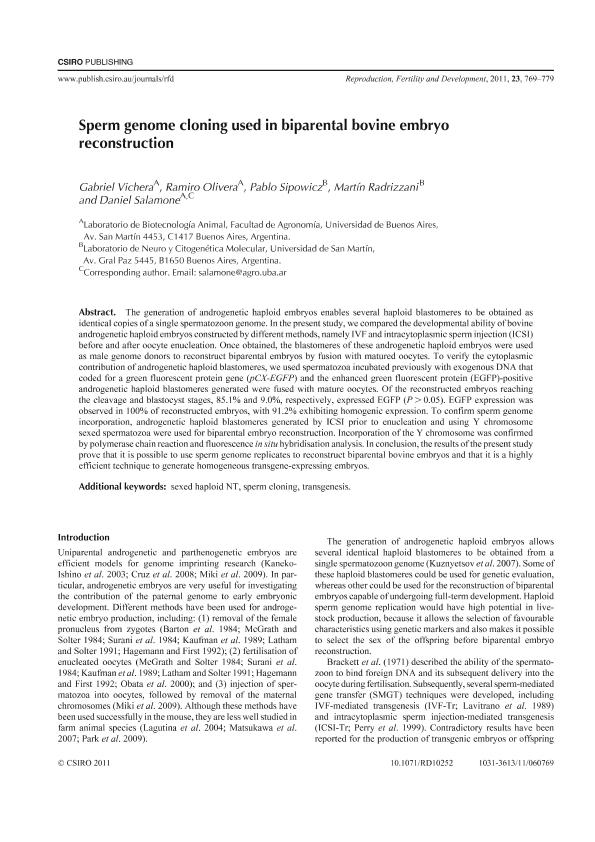Mostrar el registro sencillo del ítem
dc.contributor.author
Vichera, Gabriel Damian

dc.contributor.author
Olivera, Ramiro
dc.contributor.author
Sipowicz, Pablo
dc.contributor.author
Radrizzani Helguera, Martin

dc.contributor.author
Salamone, Daniel Felipe

dc.date.available
2017-05-11T19:36:43Z
dc.date.issued
2011-10
dc.identifier.citation
Vichera, Gabriel Damian; Olivera, Ramiro; Sipowicz, Pablo; Radrizzani Helguera, Martin; Salamone, Daniel Felipe; Sperm genome cloning used in biparental bovine embryo reconstruction; Csiro Publishing; Reproduction Fertility And Development; 23; 6; 10-2011; 769-779
dc.identifier.issn
1031-3613
dc.identifier.uri
http://hdl.handle.net/11336/16331
dc.description.abstract
The generation of androgenetic haploid embryos enables several haploid blastomeres to be obtained as identical copies of a single spermatozoon genome. In the present study, we compared the developmental ability of bovine androgenetic haploid embryos constructed by different methods, namely IVF and intracytoplasmic sperm injection (ICSI) before and after oocyte enucleation. Once obtained, the blastomeres of these androgenetic haploid embryos were used as male genome donors to reconstruct biparental embryos by fusion with matured oocytes. To verify the cytoplasmic contribution of androgenetic haploid blastomeres, we used spermatozoa incubated previously with exogenous DNA that coded for a green fluorescent protein gene (pCX-EGFP) and the enhanced green fluorescent protein (EGFP)-positive androgenetic haploid blastomeres generated were fused with mature oocytes. Of the reconstructed embryos reaching the cleavage and blastocyst stages, 85.1% and 9.0%, respectively, expressed EGFP (P . 0.05). EGFP expression was observed in 100% of reconstructed embryos, with 91.2% exhibiting homogenic expression. To confirm sperm genome incorporation, androgenetic haploid blastomeres generated by ICSI prior to enucleation and using Y chromosome sexed spermatozoa were used for biparental embryo reconstruction. Incorporation of the Y chromosome was confirmed by polymerase chain reaction and fluorescence in situ hybridisation analysis. In conclusion, the results of the present study prove that it is possible to use sperm genome replicates to reconstruct biparental bovine embryos and that it is a highly efficient technique to generate homogeneous transgene-expressing embryos.
dc.format
application/pdf
dc.language.iso
eng
dc.publisher
Csiro Publishing

dc.rights
info:eu-repo/semantics/openAccess
dc.rights.uri
https://creativecommons.org/licenses/by-nc-sa/2.5/ar/
dc.subject
Sexed Haploid Nt
dc.subject
Sperm Cloning
dc.subject
Transgenesis
dc.subject
Fertility
dc.subject.classification
Tecnología GM, clonación de ganado, selección asistida, diagnósticos, tecnología de producción de biomasa, etc.

dc.subject.classification
Biotecnología Agropecuaria

dc.subject.classification
CIENCIAS AGRÍCOLAS

dc.title
Sperm genome cloning used in biparental bovine embryo reconstruction
dc.type
info:eu-repo/semantics/article
dc.type
info:ar-repo/semantics/artículo
dc.type
info:eu-repo/semantics/publishedVersion
dc.date.updated
2017-05-08T21:18:26Z
dc.identifier.eissn
1448-5990
dc.journal.volume
23
dc.journal.number
6
dc.journal.pagination
769-779
dc.journal.pais
Australia

dc.journal.ciudad
Collingwood
dc.description.fil
Fil: Vichera, Gabriel Damian. Universidad de Buenos Aires. Facultad de Agronomía. Pabellón de Zootecnica. Laboratorio de Biotecnología Animal; Argentina. Consejo Nacional de Investigaciones Científicas y Técnicas; Argentina
dc.description.fil
Fil: Olivera, Ramiro. Universidad de Buenos Aires. Facultad de Agronomía. Pabellón de Zootecnica. Laboratorio de Biotecnología Animal; Argentina
dc.description.fil
Fil: Sipowicz, Pablo. Universidad Nacional de San Martín. Escuela de Ciencia y Tecnología. Centro de Estudios en Salud y Medio Ambiente. Laboratorio de Neuro y Citogenética Molecular; Argentina
dc.description.fil
Fil: Radrizzani Helguera, Martin. Universidad Nacional de San Martín. Escuela de Ciencia y Tecnología. Centro de Estudios en Salud y Medio Ambiente. Laboratorio de Neuro y Citogenética Molecular; Argentina. Consejo Nacional de Investigaciones Científicas y Técnicas; Argentina
dc.description.fil
Fil: Salamone, Daniel Felipe. Universidad de Buenos Aires. Facultad de Agronomía. Pabellón de Zootecnica. Laboratorio de Biotecnología Animal; Argentina. Consejo Nacional de Investigaciones Científicas y Técnicas; Argentina
dc.journal.title
Reproduction Fertility And Development

dc.relation.alternativeid
info:eu-repo/semantics/altIdentifier/doi/http://dx.doi.org/10.1071/RD10252
dc.relation.alternativeid
info:eu-repo/semantics/altIdentifier/url/http://www.publish.csiro.au/rd/RD10252
Archivos asociados
